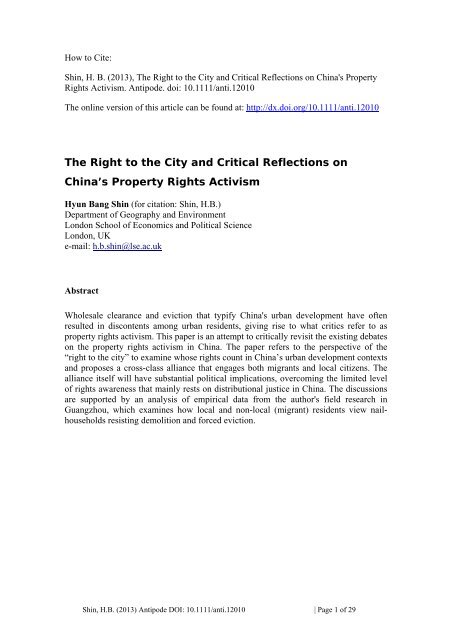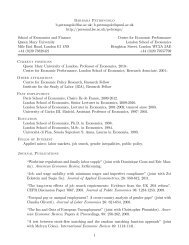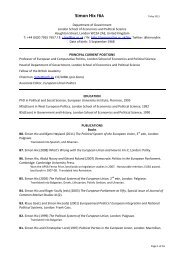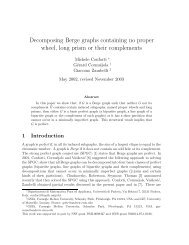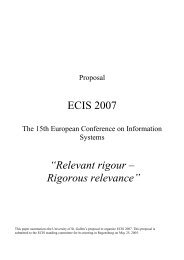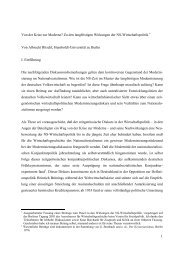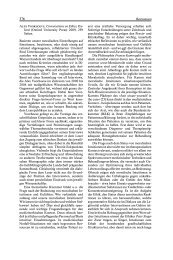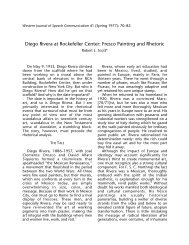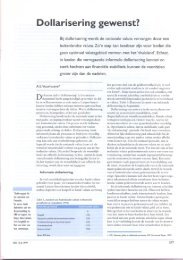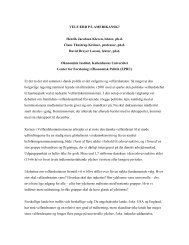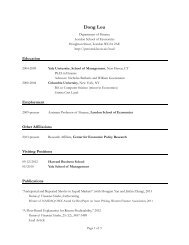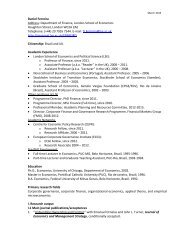View PDF - LSE - London School of Economics and Political Science
View PDF - LSE - London School of Economics and Political Science
View PDF - LSE - London School of Economics and Political Science
You also want an ePaper? Increase the reach of your titles
YUMPU automatically turns print PDFs into web optimized ePapers that Google loves.
How to Cite:<br />
Shin, H. B. (2013), The Right to the City <strong>and</strong> Critical Reflections on China's Property<br />
Rights Activism. Antipode. doi: 10.1111/anti.12010<br />
The online version <strong>of</strong> this article can be found at: http://dx.doi.org/10.1111/anti.12010<br />
The Right to the City <strong>and</strong> Critical Reflections on<br />
China’s Property Rights Activism<br />
Hyun Bang Shin (for citation: Shin, H.B.)<br />
Department <strong>of</strong> Geography <strong>and</strong> Environment<br />
<strong>London</strong> <strong>School</strong> <strong>of</strong> <strong>Economics</strong> <strong>and</strong> <strong>Political</strong> <strong>Science</strong><br />
<strong>London</strong>, UK<br />
e-mail: h.b.shin@lse.ac.uk<br />
Abstract<br />
Wholesale clearance <strong>and</strong> eviction that typify China's urban development have <strong>of</strong>ten<br />
resulted in discontents among urban residents, giving rise to what critics refer to as<br />
property rights activism. This paper is an attempt to critically revisit the existing debates<br />
on the property rights activism in China. The paper refers to the perspective <strong>of</strong> the<br />
“right to the city” to examine whose rights count in China’s urban development contexts<br />
<strong>and</strong> proposes a cross-class alliance that engages both migrants <strong>and</strong> local citizens. The<br />
alliance itself will have substantial political implications, overcoming the limited level<br />
<strong>of</strong> rights awareness that mainly rests on distributional justice in China. The discussions<br />
are supported by an analysis <strong>of</strong> empirical data from the author's field research in<br />
Guangzhou, which examines how local <strong>and</strong> non-local (migrant) residents view nailhouseholds<br />
resisting demolition <strong>and</strong> forced eviction.<br />
Shin, H.B. (2013) Antipode DOI: 10.1111/anti.12010 | Page 1 <strong>of</strong> 29
Introduction<br />
Because <strong>of</strong> their heavy focus on demolition <strong>and</strong> reconstruction, China’s urban (re-<br />
)development projects <strong>of</strong>ten incur a large scale <strong>of</strong> displacement <strong>of</strong> residents whose<br />
discontents would, in turn, emerge <strong>and</strong> escalate out <strong>of</strong> the frustration over the violation<br />
<strong>of</strong> their perceived legitimate rights to their l<strong>and</strong> <strong>and</strong> housing. The growing degree <strong>of</strong><br />
dissatisfaction is reflected in the recent popularisation <strong>of</strong> a Chinese neologism known as<br />
“ding-zi-hu” in Chinese, which is literally translated as “nail-houses” or “nailhouseholds”.<br />
As the expression suggests, nail-householders stubbornly refuse to vacate<br />
their houses, hindering the progress <strong>of</strong> urban development projects like nails sticking<br />
out <strong>and</strong> hard to be removed (see, for example, Watts 2007).<br />
To an extent, the term alludes to the rise <strong>of</strong> a contemporary Chinese version <strong>of</strong><br />
practising “right to stay put” by local residents, persistently resisting unwilling eviction<br />
<strong>and</strong> demolition (Hartman 2010 [1984]; Newman <strong>and</strong> Wyly 2006). Their struggles<br />
sometimes led to fatal incidents in which protesters took on drastic measures <strong>of</strong> risking<br />
their own lives (China Daily 2010). Nail-houses provide a vivid example <strong>of</strong> urbanites'<br />
outcry in China, reflecting what critics refer to as “property rights activism” (Lee 2008).<br />
Similarly, You-tien Hsing refers to nail-houses as “the ultimate form <strong>of</strong> localized social<br />
activism” that attempts to protect local residents’ properties from forceful expropriation<br />
(Hsing 2010:207).<br />
Against this background, this paper critically examines if property rights activism can<br />
be an effective emancipatory strategy for urban inhabitants whose livelihoods are<br />
increasingly threatened by accumulation needs. The paper resorts to the empirical<br />
findings that examine how nail-houses are viewed by urban inhabitants, <strong>and</strong> if there is a<br />
potential for these urban inhabitants to form an alliance irrespective <strong>of</strong> their socioeconomic<br />
characteristics. The set <strong>of</strong> empirical data for this paper was collected in<br />
Guangzhou between 2009 <strong>and</strong> 2011 (more details <strong>of</strong> the data collection to be found in<br />
the fourth section). In terms <strong>of</strong> the analytical perspective, I refer to the “right to the city”<br />
(Lefebvre 2003; Marcuse 2009) <strong>and</strong> contextualise whose rights count in China. In doing<br />
so, this paper makes several contributions to the literature as follows.<br />
First, the paper extends the debates on the right to the city to China’s urban contexts,<br />
<strong>and</strong> attempts to produce what Laurence Ma (2007) calls “local epistemologies”. This<br />
requires critical knowledge to be constructed about the experience <strong>of</strong> urban inhabitants,<br />
Shin, H.B. (2013) Antipode DOI: 10.1111/anti.12010 | Page 2 <strong>of</strong> 29
embedded in the existing regulatory practices <strong>and</strong> institutional settings. In particular,<br />
this paper argues that China’s rights awareness currently rests largely on the rights to<br />
subsistence or economic security, without going further to claim rights against the state.<br />
Second, this paper is an attempt to respond to the urgent call to go “beyond empiricism”<br />
in studies on urban China, <strong>and</strong> to address “the critically important issues <strong>of</strong> social <strong>and</strong><br />
environmental justice” (Ma 2007:556). While expressing “a strong sense <strong>of</strong> empathy for<br />
the feelings <strong>and</strong> experiences <strong>of</strong> the disadvantaged individuals under study” (Ma<br />
2007:563), it is also important to build grounded knowledge about how nail-houses are<br />
received by local as well as non-local (migrant) residents. Third, this study pays<br />
attention to the implications <strong>of</strong> fitting migrants into the overall struggles against topdown<br />
impositions <strong>of</strong> urban development projects that affect their homes, albeit rented.<br />
The existing debates on urbanites’ struggles against urban transformation tend to focus<br />
implicitly on permanent residents, that is registered local households who enjoy<br />
comparatively more privileged access to urban <strong>and</strong> social services based on “local<br />
citizenship” (Smart <strong>and</strong> Smart 2001). This paper, however, critically examines the<br />
limits <strong>of</strong> such prioritisation <strong>of</strong> permanent residents, <strong>and</strong> advocates the urgency <strong>of</strong><br />
forming a broader alliance <strong>of</strong> urban inhabitants, including migrants.<br />
The rest <strong>of</strong> this paper consists <strong>of</strong> five sections. The first reviews literature on the right to<br />
the city <strong>and</strong> draws implications in relation to China’s urban contexts. The second<br />
section explains how nail-housesholds have emerged in China. The third examines the<br />
empirical data that illustrate how nail-houses are viewed by local residents. By revisiting<br />
the existing literature <strong>and</strong> the empirical findings, the fourth section elaborates<br />
on the limits <strong>of</strong> property rights activism <strong>and</strong> scrutinises the awareness <strong>of</strong> rights in<br />
China. The final section concludes by elucidating the implication <strong>of</strong> advocating a crossclass<br />
alliance between local citizens <strong>and</strong> migrants.<br />
Contextualising the right to the city: Whose rights count<br />
Recently, a number <strong>of</strong> academics, activists <strong>and</strong> ordinary citizens have been drawn<br />
towards the perspective <strong>of</strong> the right to the city for contemplating the prospect <strong>of</strong> making<br />
progressive urban interventions. The perspective has also been increasingly borrowed<br />
by international organisations, such as the UN Habitat, for the acquisition <strong>of</strong><br />
redistributive justice. The Lefebvrian notion <strong>of</strong> the right to the city, however, goes<br />
beyond this, <strong>and</strong> actively seeks political programmes to intervene <strong>and</strong> take control <strong>of</strong><br />
the process <strong>of</strong> the production <strong>of</strong> urban space (Lefebvre 2003):<br />
Shin, H.B. (2013) Antipode DOI: 10.1111/anti.12010 | Page 3 <strong>of</strong> 29
the right to the city is like a cry <strong>and</strong> a dem<strong>and</strong>...The right to the city cannot be conceived<br />
<strong>of</strong> as a simple visiting right or as a return to traditional cities. It can only be formulated as<br />
a transformed <strong>and</strong> renewed right to urban life (Lefebvre 1996: 158; original emphasis)<br />
For Henri Lefebvre, the proliferation <strong>of</strong> capitalist accumulation has resulted in an<br />
increasing level <strong>of</strong> disenfranchisement <strong>of</strong> urban inhabitants. To reverse the process,<br />
Lefebvre calls for the right to the city that involves “an urban spatial approach to<br />
political struggles with the participation <strong>of</strong> all those who inhabit the city without<br />
discrimination” (Dikeç 2001:1790). According to Mark Purcell, two essential rights are<br />
at the heart <strong>of</strong> Lefebvre’s proposition: the right to participation <strong>and</strong> appropriation<br />
(Purcell 2002). The right to participation calls for urban inhabitants to take a key role in<br />
deciding the production <strong>of</strong> urban space. On the other h<strong>and</strong>, the right to appropriation<br />
involves confrontations with the process <strong>of</strong> capital accumulation that is centred around<br />
the valorisation <strong>of</strong> urban space (Purcell 2002:101-103).<br />
David Harvey pays more attention to the fundamental political economic contradictions<br />
in the capitalist accumulation processes. He argues that “Patterns in the circulation <strong>of</strong><br />
surplus value are changing but they have not altered the fact that cities...are founded on<br />
the exploitation <strong>of</strong> the many by the few” (Harvey 1976:314). Hence, Harvey focuses on<br />
the process <strong>of</strong> accumulation by dispossession, which does not simply occur at the<br />
primitive stage <strong>of</strong> capitalist development, but at various stages <strong>of</strong> capitalism to<br />
supplement existing cycles <strong>of</strong> accumulation (Harvey 2008:34). With his interpretation<br />
<strong>of</strong> the contemporary urbanisation as a spatial fix to the crisis in the accumulation <strong>of</strong><br />
capital, the right to the city is not merely about exp<strong>and</strong>ing inhabitants’ access to the city<br />
in quantitative terms but about being part <strong>of</strong> the process to make cities qualitatively<br />
different (Harvey 2003). The struggle to acquire the right to the city therefore inevitably<br />
centres on struggles against the capitalist accumulation.<br />
The right to the city is far more than the individual liberty to access urban resources: it is a<br />
right to change ourselves by changing the city. It is, moreover, a common rather than an<br />
individual right since this transformation inevitably depends upon the exercise <strong>of</strong> a<br />
collective power to reshape the processes <strong>of</strong> urbanization (Harvey 2008:23)<br />
In this regard, the dem<strong>and</strong> for the right to the city should be about gaining “greater<br />
democratic control over the production <strong>and</strong> utilization <strong>of</strong> the surplus” (Harvey 2008:37).<br />
Lefebvre’s right to the city is also based on autogestion, which refers to the “democratic<br />
participation, workers’ self-management, <strong>and</strong> control <strong>of</strong> ordinary peoples’ destinies”<br />
<strong>and</strong> which “must be perpetually negotiated <strong>and</strong> enacted, relentlessly practiced <strong>and</strong><br />
Shin, H.B. (2013) Antipode DOI: 10.1111/anti.12010 | Page 4 <strong>of</strong> 29
earned” (Merrifield 2006:140). The key is to “bring people together to oppose the<br />
‘omnipotence’ <strong>of</strong> the state <strong>and</strong> multinational capital” (ibid.).<br />
One <strong>of</strong> the challenging questions is whose rights count, which is at the core <strong>of</strong> Peter<br />
Marcuse’s enquiry (Marcuse 2009). Marcuse’s reinterpretation <strong>of</strong> Lefebvre underst<strong>and</strong>s<br />
the right to the city as involving “an exigent dem<strong>and</strong> by those deprived <strong>of</strong> basic material<br />
<strong>and</strong> existing legal rights, <strong>and</strong> an aspiration for the future by those discontented with life<br />
as they see it around them, perceived as limiting their own potentials for growth <strong>and</strong><br />
creativity” (2009:190). Here, Marcuse makes a distinction using economic <strong>and</strong> cultural<br />
terms to define whose right we need to protect <strong>and</strong> exp<strong>and</strong>. Economically, the deprived<br />
are classified to include the excluded (who are part <strong>of</strong> the capitalist system but without<br />
the same level <strong>of</strong> social protections gained by the working class) <strong>and</strong> the working class<br />
itself. In cultural terms, Marcuse puts emphasis on exp<strong>and</strong>ing the right <strong>of</strong> the directly<br />
oppressed (in race, ethnicity <strong>and</strong> so on) <strong>and</strong> the alienated (<strong>of</strong> any factions <strong>of</strong> economic<br />
class <strong>and</strong> social groups that resist the ruling system) (Marcuse 2009). Other than these,<br />
those ruling groups who hold material interests (eg business people, gentry, capitalists,<br />
establishment intelligentsia <strong>and</strong> political elites) are thought to have already acquired the<br />
right to the city in their own terms. This point has also been echoed by David Harvey<br />
who also laments that “Increasingly, we see the right to the city falling into the h<strong>and</strong>s <strong>of</strong><br />
private or quasi-private interests” (Harvey 2008:38).<br />
The perspective <strong>of</strong> the right to the city has been around for some time, but it is yet to be<br />
translated into fully established urban practices. It is imperative to seek strategies<br />
attuned to various urban contexts, as the forms <strong>and</strong> shapes <strong>of</strong> the struggle for the right to<br />
the city should be imagined by taking into account the local configuration <strong>of</strong><br />
institutional regulatory structure as well as the contradictions within specific political<br />
economic systems. As Dikeç states, “approaches to, <strong>and</strong> principles <strong>of</strong>, justice are time<br />
<strong>and</strong> space specific” (2001: 1788). Therefore, any discussions about identifying the<br />
emancipatory right to the city <strong>and</strong> organising its corresponding movement should<br />
address this spatio-temporal specificity. With the need to involve marginalised urban<br />
populations <strong>and</strong> form a solidarity that encompasses conventional class-based labour<br />
movements, the right to the city movement becomes a struggle that strives to secure<br />
access not only to urban space but also to “political space” (Dikeç 2001:1790), while<br />
being sensitive to specific urban socio-political, economic <strong>and</strong> institutional contexts.<br />
Shin, H.B. (2013) Antipode DOI: 10.1111/anti.12010 | Page 5 <strong>of</strong> 29
What are the implications <strong>of</strong> such discourses regarding whose rights count in China’s<br />
urban contexts? At present, the fate <strong>of</strong> urban inhabitants facing (re-)development<br />
projects is heavily determined by existing sets <strong>of</strong> regulations <strong>and</strong> institutional<br />
arrangements. The access to various urban <strong>and</strong> social services in China, including<br />
compensation schemes upon displacement, is conferred upon a particular notion <strong>of</strong><br />
“citizenship” that has been redefined in the process <strong>of</strong> the country’s economic<br />
transition: that is to say, citizenship in China is rendered as a right to socio-economic<br />
benefits rather than “political claims against the State” (Keane 2001).<br />
One <strong>of</strong> the persistent institutions that shape the geography <strong>of</strong> social rights is the<br />
household registration system called hukou in Chinese, which has been in place since its<br />
formal implementation in late 1950s. It functions as a tenacious measure to dissociate<br />
migrants with no permanent local hukou from accessing social services in their<br />
destination cities (Solinger 1999). Li Zhang also finds that migrants are “still <strong>of</strong>ficially<br />
classified as temporary residents in the city <strong>and</strong> treated as noncitizens” (2002:317-318),<br />
facing “prejudice <strong>and</strong> unequal treatment in everyday life” as well as denial <strong>of</strong> basic<br />
services such as education for children <strong>and</strong> access to state-subsidised (rental) housing<br />
(2002:317-318). It is apparent that the terms <strong>and</strong> conditions <strong>of</strong> exercising the citizenship<br />
are determined by the state (Miraftab <strong>and</strong> Wills 2005). Recent evidences also suggest<br />
that there has been a move towards blurring the existing boundary between agricultural<br />
<strong>and</strong> non-agricultural hukous, <strong>and</strong> reshaping the entitlement <strong>of</strong> citizens. This has been<br />
strengthening the separation <strong>of</strong> permanent residents with local hukous from migrants<br />
(Smart <strong>and</strong> Lin 2007; Smart <strong>and</strong> Smart 2001).<br />
The significance <strong>of</strong> hukou system is obviously pronounced in urban development<br />
processes. Compensation measures for displacees, whether in-kind (eg relocation<br />
housing) or cash based, largely take into account one’s tenure status, ownership <strong>of</strong><br />
formally acknowledged property rights <strong>and</strong> in particular, possession <strong>of</strong> a permanent<br />
local hukou (in Chinese, changzhu hukou). The regulations for urban housing<br />
demolition in Beijing in 1991 states that owners <strong>and</strong> users <strong>of</strong> the buildings subject to<br />
demolition are entitled to compensation. An individual user means, by the regulation, a<br />
permanent hukou holder registered within the demolition boundary (BMG 1991). The<br />
2001 revision to the regulations more specifically defined property-owners, public<br />
tenants or those tenants in rent-controlled private dwellings as the major recipients <strong>of</strong><br />
compensation (BMG 2001). For residents in rural villages, their membership in village<br />
Shin, H.B. (2013) Antipode DOI: 10.1111/anti.12010 | Page 6 <strong>of</strong> 29
collectives determines their eligibility for the receipt <strong>of</strong> benefits, if any, from village<br />
redevelopment (Hsing 2010).<br />
As a result, most private tenants at present are effectively excluded from receiving<br />
compensation <strong>and</strong> are just left to negotiation with their l<strong>and</strong>lords: the outcome is heavily<br />
skewed in favour <strong>of</strong> l<strong>and</strong>lords. The most negatively affected <strong>and</strong> disadvantaged by such<br />
negotiations are the migrant tenants without permanent local hukous. Therefore, calls<br />
for the right to the city in China’s urban contexts would require close attention to the<br />
institution <strong>of</strong> hukou that differentiates urban inhabitants’ experience.<br />
Displacement, nail-houses, <strong>and</strong> property rights activism<br />
Since the early 1990s, China’s major cities have seen the intensification <strong>of</strong> urban<br />
redevelopment. Beijing, for instance, saw the introduction <strong>of</strong> a new set <strong>of</strong> policy tools in<br />
1990, which heavily relied on inputs, both technical <strong>and</strong> financial, from developers who<br />
are not necessarily private. The rapid urban transformation through inner-city<br />
redevelopment as well as sub-urban expansion has been driven by urban accumulation<br />
needs that rest on mobilising l<strong>and</strong> resources (Hsing 2010; Wu 2009). The accumulation<br />
needs involve the conversion <strong>of</strong> rural farml<strong>and</strong>s under villagers’ collective ownership<br />
into urban construction l<strong>and</strong>s for urban governments to secure more l<strong>and</strong> resources. The<br />
assembly <strong>of</strong> urban l<strong>and</strong> <strong>and</strong> the transfer <strong>of</strong> l<strong>and</strong> use rights have become critical to local<br />
state’s performance <strong>and</strong> public finance (Ding 2005). In this process, clearance <strong>and</strong><br />
demolition have also become the norm <strong>of</strong> urban spatial transformation, accompanied by<br />
a large scale <strong>of</strong> displacement.<br />
While there is a growing emphasis on establishing the “rule <strong>of</strong> law”, opportunities for<br />
citizens to put forward their legal claims are still limited. Because <strong>of</strong> this, protestors<br />
<strong>of</strong>ten make use <strong>of</strong> various “non-legal modes <strong>of</strong> resistance, including protests, petitions,<br />
<strong>and</strong> deadly confrontations” (Cai 2007:194). The measures would include: persistent<br />
appeals to higher courts; media exposure; winning the support <strong>of</strong> sympathetic (<strong>of</strong>ten<br />
high-ranking) leaders (O’Brien <strong>and</strong> Li 2005:38-42). Although protesters increasingly<br />
resort to law suits (see Hsing 2010; Johnson 2004; Zhang 2004), their attempts are <strong>of</strong>ten<br />
marred by bureaucratic processes that act as barriers to plaintiffs. Besides, the existing<br />
judicial processes tend to work in greater favour <strong>of</strong> governments <strong>and</strong> developers<br />
(Human Rights Watch 2004; Johnson 2004). Few people tend to have the will <strong>and</strong><br />
intention to resort to formal measures when it comes to contending the state (Li 2004).<br />
Shin, H.B. (2013) Antipode DOI: 10.1111/anti.12010 | Page 7 <strong>of</strong> 29
The lack <strong>of</strong> effective means to change the course <strong>of</strong> neighbourhood demolition<br />
consequently results in residents' discontents. Nail-houses, so-called "individualized<br />
modes <strong>of</strong> protest" (Hsing 2010:18), emerged out <strong>of</strong> such discontents as some residents’<br />
way <strong>of</strong> exercising their “right to stay put” against external forces driven by l<strong>and</strong>-based<br />
political <strong>and</strong> business interests (see Figure 1).<br />
Figure 1: Defiant building st<strong>and</strong>ing alone in a cleared site (source: photo by the author, 2008)<br />
Much <strong>of</strong> the on-going debates on property rights activism largely focus on those with<br />
entitlements based on their legal property ownership <strong>and</strong> permanent hukou status. For<br />
instance, Cai (2007:194) analyses homeowners' protests to protect their legal rights,<br />
stating that “The laws that are supposed to protect citizens are ineffective, <strong>and</strong> those<br />
stipulations made <strong>and</strong> enforced by governments at the central <strong>and</strong> local levels ignore<br />
their [homeowners’] interests”. This focus on homeowners may be grounded in the<br />
notion that they are the legitimate holders <strong>of</strong> property rights based on titles <strong>and</strong> deeds,<br />
without considering the formal <strong>and</strong> informal rights to the use <strong>of</strong> houses <strong>and</strong> l<strong>and</strong>s that<br />
many migrants might hold on to. Migrants’ rights are also less visible in Hsing’s<br />
insightful publication on l<strong>and</strong>-centred accumulation <strong>and</strong> l<strong>and</strong> politics (Hsing 2010).<br />
Hsing refers to “two types <strong>of</strong> housing protests in large cities” which include “property<br />
rights protests <strong>and</strong> residents’ rights protests” (2010:61). Here, the former refers to the<br />
protests by “private homeowners in the prerevolutionary era, whose properties were<br />
appropriated by the Beijing Municipal Government” (61), while the latter refers to those<br />
launched by “property owners <strong>and</strong> tenants” who “shared a territorial identity as urban<br />
residents” (2012:62). She further contends that “Residency was the physical anchor for<br />
Shin, H.B. (2013) Antipode DOI: 10.1111/anti.12010 | Page 8 <strong>of</strong> 29
the quotidian support networks <strong>of</strong> job, family, community, <strong>and</strong> urban service-the lifeworlds-<strong>of</strong><br />
city residents” (62). However, these discussions do not take into account the<br />
hukou factor or residents’ varying degree <strong>of</strong> entitlements.<br />
St<strong>and</strong>ing in the way <strong>of</strong> development projects, nail-houses are <strong>of</strong>ten portrayed negatively<br />
by government <strong>of</strong>ficials who may claim them to be <strong>of</strong> nuisance or trouble-makers. As<br />
Hsing asserts, protesters are “presented as uncooperative <strong>and</strong> opportunistic negotiators<br />
for higher compensation <strong>and</strong> are accused <strong>of</strong> sacrificing the public interests for personal<br />
gain, <strong>and</strong> even <strong>of</strong> causing housing price hikes” (2010:78). Under these circumstances,<br />
how do local residents with various conditions (eg housing tenure, hukou, migration)<br />
view nail-households? Do they also regard nail-house activities as ad hoc events or<br />
something that emerges due to structural causes? In particular, what are the views<br />
among local residents towards migrants claiming a stake in the projects that involve the<br />
demolition <strong>of</strong> their homes? These questions form the basis <strong>of</strong> the analysis to be drawn<br />
in the following section, reporting the findings from my field research conducted in<br />
Guangzhou over the period between 2009 <strong>and</strong> 2011. The empirical findings in the<br />
following section are based on my site observation, a questionnaire survey <strong>and</strong><br />
qualitative semi-structured interviews with local residents.<br />
‘Local epistemology’ <strong>of</strong> nail-houses<br />
Resistance <strong>and</strong> protests in contemporary China increasingly take a variety <strong>of</strong> forms,<br />
ranging from individual or collective lawsuits to non-legal modes such as petitions <strong>and</strong><br />
violent confrontations (Cai 2007; O’Brien <strong>and</strong> Li 2005). There would also be an array<br />
<strong>of</strong> “everyday resistance” that remain “invisible” (Perry <strong>and</strong> Selden 2003:2). For<br />
instance, when people resist eviction <strong>and</strong> refuse to vacate, they may simultaneously<br />
organise petitions to approach sympathetic high-ranking <strong>of</strong>ficials <strong>and</strong> seek their<br />
intervention or moral support. They may also approach media that might feel<br />
compassionate about their cases.<br />
If nail-house activities are acknowledged as one form <strong>of</strong> radical protest, it will also be<br />
meaningful to scrutinise nail-houses in order to gauge the views <strong>of</strong> permanent local<br />
residents <strong>and</strong> migrants on property rights activism <strong>and</strong> rights awareness. Two main<br />
reasons can be put forward: first, while riots or collective protests are much less<br />
frequent, nail-house activities have recently become one <strong>of</strong> the most visible forms <strong>of</strong><br />
exercising property rights activism. Secondly, unlike other modes <strong>of</strong> resistance such as<br />
Shin, H.B. (2013) Antipode DOI: 10.1111/anti.12010 | Page 9 <strong>of</strong> 29
petitions, nail-houses have been negatively depicted by governments as an act <strong>of</strong> selfish<br />
pursuit against public interests. However, the existing literature has not much discussed<br />
how urban inhabitants themselves view nail-houses.<br />
In this regard, this section resorts to empirical findings to address three key issues: the<br />
extent to which the rise <strong>of</strong> nail-houses is deemed inevitable; local residents’ support for<br />
nail-house activities despite their negative portrayal by local governments; local<br />
residents’ views on providing preferential treatments in terms <strong>of</strong> compensation on the<br />
basis <strong>of</strong> “local citizenship”. These empirical findings will help us critically re-visit, in<br />
the subsequent sections, the pros <strong>and</strong> cons <strong>of</strong> growing awareness <strong>of</strong> rights <strong>and</strong> property<br />
rights activism in urban China.<br />
Outline <strong>of</strong> neighbourhoods for field research<br />
Three residential areas were selectedfor the study: one village-in-the-city<br />
(chengzhongcun in Chinese) called Pazhou village in Haizhu District <strong>and</strong> two inner-city<br />
neighbourhoods located in Liwan <strong>and</strong> Yuexiu Districts (see Figure 2). They were<br />
selected for their neighbourhood characteristics <strong>and</strong> urban redevelopment experiences.<br />
At the time <strong>of</strong> the survey, they were all under threat <strong>of</strong> demolition, influenced heavily<br />
by the municipal drive to prepare the city for the hosting <strong>of</strong> the 2010 Summer Asian<br />
Games.<br />
Pazhou village is one <strong>of</strong> the numerous villages-in-the-city, frequently found in<br />
Guangzhou as well as in the wider Pearl River Delta region. These villages-in-the-city<br />
are former rural villages that have become urbanised in the midst <strong>of</strong> Guangzhou’s<br />
outward expansion (Chung 2010). They are known for a high share <strong>of</strong> migrants, a<br />
proliferation <strong>of</strong> illegal construction <strong>of</strong> high-density rental buildings <strong>and</strong> a collectively<br />
led village governance structure that sometimes comes into conflict with higher-level<br />
urban authorities. According to the district planning bureau, Pazhou used to<br />
accommodate more than 3,000 villagers <strong>and</strong> a large population <strong>of</strong> migrants whose<br />
number at peak time might reach nearly 10,000 people. The relocation <strong>of</strong> villagers as<br />
part <strong>of</strong> the village redevelopment process commenced in March 2010 (Guangzhou Daily<br />
2010).<br />
The other two inner-city neighbourhoods were known for more regular forms <strong>of</strong><br />
buildings with historic origins <strong>and</strong> a relatively high share <strong>of</strong> homeowners <strong>and</strong> public<br />
rental tenants. In Enning Road Redevelopment District, one <strong>of</strong> the two inner-city<br />
Shin, H.B. (2013) Antipode DOI: 10.1111/anti.12010 | Page 10 <strong>of</strong> 29
neighbourhoods, 1950 households were to be relocated. By the end <strong>of</strong> July 2009, about<br />
61% signed the compensation agreement (Information Times 2009; see Shin 2013 for<br />
more discussions about the redevelopment <strong>of</strong> Enning Road). The other neighbourhood<br />
Yuexiu South was also subject to redevelopment, <strong>and</strong> had over 600 households<br />
although the progress was slow. The share <strong>of</strong> public housing in these two<br />
neighbourhoods reached about 40% <strong>and</strong> 50% respectively, thus suggesting a reasonably<br />
high share <strong>of</strong> dwellings in private h<strong>and</strong>s.<br />
Shin, H.B. (2013) Antipode DOI: 10.1111/anti.12010 | Page 11 <strong>of</strong> 29
Residents’ views on nail-houses: Inevitability <strong>of</strong> nail-house emergence<br />
As indicated earlier, nail-house activities have come to be one <strong>of</strong> the most visible forms<br />
<strong>of</strong> defending residents’ properties against demolition <strong>and</strong> eviction. In the midst <strong>of</strong> local<br />
government’s negative portrayal <strong>of</strong> nail-houses, one <strong>of</strong> the questions this paper seeks to<br />
address is to what extent urban inhabitants regard nail-houses as inevitable, <strong>and</strong> how<br />
their views are affected by their own household characteristics related to housing tenure,<br />
household registration <strong>and</strong> migration status.<br />
The discussions in this section make use <strong>of</strong> the questionnaire survey data collected in<br />
late 2009. The questionnaire survey was part <strong>of</strong> a larger project that was to investigate<br />
local residents’ housing history <strong>and</strong> their access to relocation dwellings in times <strong>of</strong><br />
neighbourhood redevelopment. In total, 675 responses were collected from the<br />
questionnaire survey: 255 from Pazhou village, 260 from Enning Road <strong>and</strong> 160 from<br />
Yuexiu South. 1 All respondents were residing in their neighbourhoods at the time <strong>of</strong><br />
the survey.<br />
The survey included some questions to check respondents’ awareness <strong>of</strong> the term “nailhouse”,<br />
<strong>and</strong> if yes, to what extent they regard the phenomenon <strong>of</strong> nail-houses as<br />
inevitable. Here, the dependent variable is about “Do you agree or disagree that ‘nailhouses’<br />
are an inevitable phenomenon?” with options <strong>of</strong> (1) very much disagree, (2)<br />
somewhat disagree, (3) don’t know (4) somewhat agree, (5) very much agree. <strong>View</strong>ing<br />
nail-houses as an inevitable phenomenon would indicate that respondents do not regard<br />
them as an ad-hoc or idiosyncratic phenomenon but as having resulted from structural<br />
reasons. Given the local governments’ overwhelmingly negative portrayal <strong>of</strong> nailhouses,<br />
respondents who view nail-houses as inevitable may be interpreted as being<br />
supportive <strong>of</strong> nail-houses to some extent, although this may not always be the case. As a<br />
matter <strong>of</strong> fact, 460 respondents turned out to be aware <strong>of</strong> nail-houses, <strong>and</strong> <strong>of</strong> these, 438<br />
valid respondents were subject to the summary statistics reported in Table 1. 2 Here, the<br />
valid responses refer to those samples without missing values for the following four<br />
main variables: housing tenure; hukou status; neighbourhood location; concern for<br />
demolition in the near future.<br />
As indicated in the table, it turns out that 53% <strong>of</strong> all valid respondents regarded the<br />
emergence <strong>of</strong> nail-houses as inevitable, while 30% thought otherwise. The trend is more<br />
or less similar even if the respondents are broken down into sub-categories. The<br />
Shin, H.B. (2013) Antipode DOI: 10.1111/anti.12010 | Page 12 <strong>of</strong> 29
majority <strong>of</strong> homeowners <strong>and</strong> public rental tenants (56% 53% respectively)<br />
acknowledged the inevitability <strong>of</strong> the nail-house phenomenon. This is somewhat<br />
expected, given their possession <strong>of</strong> tangible property assets in the case <strong>of</strong> homeowners<br />
in particular, <strong>and</strong> their legally protected, albeit inadequate, entitlement to compensation<br />
upon their house demolition. What is interesting is the large number <strong>of</strong> private tenants<br />
(49%), mostly migrants, who are also thinking in the same way even though they hardly<br />
receive compensation upon neighbourhood redevelopment <strong>and</strong> demolition <strong>of</strong> their rental<br />
dwellings.<br />
Shin, H.B. (2013) Antipode DOI: 10.1111/anti.12010 | Page 13 <strong>of</strong> 29
As for the hukou status, while 54% <strong>of</strong> Guangzhou hukou holders acknowledged the<br />
inevitability <strong>of</strong> nail-houses, one in two non-Guangzhou hukou holders (51%) also<br />
indicated a similar sentiment. With regard to the neighbourhood location, the majority<br />
<strong>of</strong> the respondents from the inner-city neighbourhoods <strong>and</strong> Pazhou village also shared<br />
this sentiment. In the case <strong>of</strong> those respondents with a differing degree <strong>of</strong> concern for<br />
demolition <strong>of</strong> their homes, it appears that those people who were more concerned for<br />
demolition felt more strongly for the inevitability <strong>of</strong> nail-house activities: about 61% <strong>of</strong><br />
the respondents who were very much worried about the demolition regarded nail-houses<br />
as inevitable, while 51% <strong>of</strong> those not worried at all shared the same view. In summary,<br />
the survey results reveal that there is a compelling degree <strong>of</strong> consensus that the rise <strong>of</strong><br />
nail-houses is considered as inevitable, <strong>and</strong> this view is fairly consistent irrespective <strong>of</strong><br />
people’s housing tenure as well as their migration status.<br />
Discontents <strong>and</strong> support for nail-houses<br />
Additional semi-structured qualitative interviews were carried out in late 2010 with<br />
local residents in order to further scrutinise their views. In total, 28 interviews were<br />
carried out: eight were the original participants in the initial survey, <strong>and</strong> due to practical<br />
constraints, the rest were recruited through snowballing (recruitment <strong>of</strong> further<br />
interviewees through known contacts). Thirteen were from Pazhou, <strong>and</strong> the rest from<br />
Enning Road. Most interviewees were holders <strong>of</strong> Guangzhou hukou, while four from<br />
Pazhou were migrants. The interviewees from Pazhou were all displaced from the<br />
village at the time <strong>of</strong> interviewing. As for the interviewees from the Enning Road<br />
redevelopment district, two were already displaced but the rest were still living in the<br />
neighbourhood.<br />
Local governments <strong>of</strong>ten portray nail-houses negatively. This stance is clearly visible in<br />
the latest propag<strong>and</strong>a posters that I came across in Pazhou (see Figure 3). These<br />
propog<strong>and</strong>a posters depict nail-households as selfish neighbours who stood in the way<br />
<strong>of</strong> local community’s collective interests. Reflecting this negative painting <strong>of</strong> nailhouses<br />
by local governments, several interviewees readily criticised nail-houses for<br />
being driven by self-interests, getting in the way <strong>of</strong> neighbourhood improvement. For<br />
instance, a migrant tenant from Pazhou (P2) stated that “I feel their practice is not right.<br />
Today’s houses are all messy, <strong>and</strong> all these buildings are poorly constructed. Under this<br />
situation, you cannot just think <strong>of</strong> your family only”. 3 Another public tenant from<br />
Enning Road (E1) also points out that “If you are a private house-owner, sometimes you<br />
Shin, H.B. (2013) Antipode DOI: 10.1111/anti.12010 | Page 14 <strong>of</strong> 29
only think <strong>of</strong> yourself. The environment is going to be improved, so why trouble the<br />
government?”<br />
Figure 3: Posters criticising nail-houses for their interference in the timely delivery <strong>of</strong><br />
development projects (source: photo by the author, 2010)<br />
Nevertheless, many more were found supportive, referring to their discontents emerging<br />
out <strong>of</strong> redevelopment processes. Some interviewees even pointed out that nail-house<br />
activities are to put forward their reasonable dem<strong>and</strong> for compensation which fails to<br />
meet residents' expectation, especially that <strong>of</strong> owner occupiers. The discontents are<br />
mainly about the negative impacts on their property-related assets. These range from the<br />
loss <strong>of</strong> rental income to the unnecessary increase in post-displacement housing<br />
expenditure. For instance, for the residents in Enning Road, the average amount <strong>of</strong> cash<br />
compensation, including incentives for timely moving, was around 9,000 yuan per<br />
square metre in mid-2008 (Nanfang Dushibao 2008): This level <strong>of</strong> cash compensation<br />
seems to have remained the same for a while <strong>and</strong> increased incrementally to reach<br />
11,000 ~ 13,000 yuan per square metre by mid-2011 (Guangzhou Daily 2011). The size<br />
<strong>of</strong> cash compensation was considered to be far inadequate to finance a flat for relocation<br />
into adjacent areas where housing prices have also substantially increased during the<br />
period.<br />
Shin, H.B. (2013) Antipode DOI: 10.1111/anti.12010 | Page 15 <strong>of</strong> 29
The frustration also resulted from the residents’ concerns over ambiguous property<br />
rights which can be seen as a legacy <strong>of</strong> the housing allocation practices during the era <strong>of</strong><br />
planned economy (Shin 2010). Although constructing additional floor space to address<br />
overcrowded living conditions was a common practice, this was not always recorded<br />
<strong>and</strong>/or endorsed by local governments. For example, a resident from Enning Road (E10)<br />
who lives in a house inherited from his gr<strong>and</strong>mother says that his total floor area<br />
amounts to 99.97 square metres, due to the conversion <strong>of</strong> what originally was a onestorey<br />
dwelling into the current three-storey unit to address the space needs <strong>of</strong> his<br />
family. He further suggests that “many in this area have title deeds that say one-storey<br />
[dwelling] but in reality have [additional] two or three floors constructed. It will be<br />
difficult for them to agree [on compensation]. This is just a historic legacy”. An original<br />
villager (P4) who temporarily lives as a private tenant after his displacement from<br />
Pazhou also states:<br />
“I underst<strong>and</strong> their [nail-householders’] requests, because they have their reasonable [heli<br />
in Chinese] dem<strong>and</strong>s [emphasis by the author]. I think they are being reasonable...<br />
Previously, many people with children built additional floors, but after construction, did<br />
not report them, resulting in a smaller space [entered] in their housing certificates than the<br />
actual size. It is not right not to be able to receive compensation [because <strong>of</strong> that].”<br />
The use <strong>of</strong> the expression, “reasonable dem<strong>and</strong>s”, was noticeable in the interviews with<br />
many other local residents too. A Guangzhou urban hukou holder (E8) who apparently<br />
has a house owned in Enning Road says, “I only have a reasonable dem<strong>and</strong>... Without an<br />
<strong>of</strong>ficial guarantee [<strong>of</strong> a house for relocation], I would not move <strong>and</strong> rather die [here]”.<br />
Another public rental tenant (E12) also agrees that people would not become nailhouseholders<br />
“if reasonable arrangements were provided”. The expression <strong>of</strong><br />
“reasonable” indicates that nail-householders’ dem<strong>and</strong>s are understood as to claim what<br />
rightfully belongs to them.<br />
<strong>View</strong>s on granting compensation to migrants<br />
Migrants without a local hukou face limited access to various services that their host<br />
cities increasingly provide on the basis <strong>of</strong> “local citizenship” (Smart <strong>and</strong> Smart 2001).<br />
The migrants’ unequal access to urban entitlements is also pointed out by Li Zhang who<br />
refers to the preferential treatments <strong>of</strong> permanent urban residents as the rise <strong>of</strong> “urban<br />
nativism” (2002:327). Questions arise here: should migrants also be granted<br />
compensation? If so, on what basis <strong>and</strong> to what extent?<br />
Shin, H.B. (2013) Antipode DOI: 10.1111/anti.12010 | Page 16 <strong>of</strong> 29
Quite interestingly, several interviewees, including both migrants <strong>and</strong> permanent local<br />
residents, expressed their support for the idea <strong>of</strong> granting some kind <strong>of</strong> compensation to<br />
migrants. Migrants’ asset investment in host cities is pointed out as one <strong>of</strong> the reasons<br />
for advocating the provision <strong>of</strong> compensation for migrants: This essentially builds upon<br />
people’s notion <strong>of</strong> associating compensation with property ownership rights.<br />
A migrant interviewee (P10), who had lived in Pazhou for about 10 years before his<br />
displacement <strong>and</strong> owned a residential property therein, argues that migrants should<br />
“receive compensation, as numerous migrants have invested in the neighbourhood”.<br />
This view is shared by an elderly migrant interviewee (P3) who was displaced after<br />
living in Pazhou for about 2 years. He was in favour <strong>of</strong> allowing compensation “if<br />
[buildings were] rented <strong>and</strong> have a signed contract”, adding that:<br />
“Let me give you an example...The father <strong>of</strong> that man who set up the factory had invested<br />
money there [in Pazhou], renting a building from someone with a surname Xie <strong>and</strong> signed<br />
a contract...In the contract it was as such that relocation compensation would all be his<br />
l<strong>and</strong>lord’s. The result was that he did not receive any. It was miserable for him. He<br />
invested a lot <strong>of</strong> money <strong>and</strong> did not retrieve any”<br />
Migrants’ contribution to the city <strong>and</strong> their neighbourhoods was also highlighted. For<br />
instance, a local villager from Pazhou (P4), holding a Guangzhou hukou, advocates the<br />
idea <strong>of</strong> making relocation provision for migrants on the condition that their<br />
contributions to the city can be proven. He further iterates:<br />
“Whether or not to gain the benefits [that is, compensation] should assume some<br />
conditions <strong>and</strong> [each case] differently treated. Some people are working within the village,<br />
having worked many years, <strong>and</strong> it is right for them to receive some benefits. But, for those<br />
who have recently arrived <strong>and</strong> rented their dwelling, why should they be given<br />
compensation?”<br />
Compensation in general may include monetary compensation as well as in-kind<br />
compensation (relocation or re-housing units). However, when referring to migrant<br />
tenants’ eligibility, respondents tend to make a distinction between monetary<br />
compensation (buchang in Chinese) <strong>and</strong> relocation arrangements (anzhi in Chinese),<br />
associating the former with property ownership <strong>and</strong> the latter with tenancy: Instead <strong>of</strong><br />
referring to compensation, an original villager (P6) who used to own a house before his<br />
displacement from Pazhou (P6) prefers to assert that migrants “should be given<br />
relocation [housing], since they have contributed to the construction <strong>and</strong> development<br />
Shin, H.B. (2013) Antipode DOI: 10.1111/anti.12010 | Page 17 <strong>of</strong> 29
<strong>of</strong> Guangzhou”. This is further reiterated by another local villager (P9) who explains<br />
that:<br />
“As far as I can see, they don’t get compensation. After all, they do not have property<br />
rights [<strong>of</strong> the house they live in]. But, they should be subject to relocation measures. They<br />
have contributed a lot to the construction <strong>of</strong> Guangzhou. Demolition <strong>and</strong> house-moving<br />
would have a great impact on people, <strong>and</strong> they should be relocated”<br />
Migrants’ long-term residency in their host cities has increasingly become a<br />
characteristic <strong>of</strong> the population. In the case <strong>of</strong> those survey respondents reported in<br />
Table 1, the average number <strong>of</strong> years lived in Guangzhou turned out to be about 11<br />
years for the migrants, which is a relatively long period (44 years in the case <strong>of</strong><br />
permanent local residents). Their number <strong>of</strong> years lived in the studied neighbourhoods<br />
was 6.7 years (35 years in the case <strong>of</strong> permanent local residents). In this regard,<br />
migrants’ long-term residency was cited as another reason for an owner-occupier (P11)<br />
to be in favour <strong>of</strong> giving compensation to migrant tenants:<br />
“Whether or not to give compensation, it is difficult to say... there are some [migrants]<br />
renting for a relatively long period. There used to be a household who lived close to me<br />
<strong>and</strong> had been living [in the village] for many years. I see them as equivalent to local<br />
residents, help him look after the small child...They’ve moved out some years ago, but still<br />
come back to see us.”<br />
A public rental tenant in Enning Road was more explicit in relation to the issue <strong>of</strong><br />
compensation based on migrants’ status: “If the policy is relaxed, there should also be<br />
some compensation [for migrants], because they are also citizens [gongmin in Chinese]<br />
<strong>and</strong> are equal [pingdeng in Chinese]. Citizens should not be treated unequally” (E14).<br />
However, it should also be noted that the Chinese use <strong>of</strong> gongmin or citizen “connotes<br />
collective membership in the polity, rather than a claim to individual or inalienable<br />
rights vis-a-vis the state” (Perry, 2008:46).<br />
Overall, the interviewees from Pazhou were more explicitly elaborating on their<br />
supporting views with regard to migrants' receipt <strong>of</strong> compensation than inner-city<br />
interviewees did. Their supporting views might have to do with migrants’ daily <strong>and</strong><br />
commercial activities concentrated in the village-in-the-city <strong>and</strong> the resulting economic<br />
benefits as well as social interactions the local villagers shared. While the views <strong>of</strong> the<br />
above interviewees may not be conclusive nor representative <strong>of</strong> all the residents, they<br />
indicate a greater potential in a place like the Pazhou village to promote a sense <strong>of</strong><br />
solidarity on the basis <strong>of</strong> non-material interests <strong>and</strong> mutual underst<strong>and</strong>ings, which<br />
Shin, H.B. (2013) Antipode DOI: 10.1111/anti.12010 | Page 18 <strong>of</strong> 29
would help them express their concern <strong>and</strong> put forward greater claims on imagining<br />
what kind <strong>of</strong> city is to be constructed.<br />
Nevertheless, it should also be noted that many interviewees were still acknowledging<br />
the status quo defined by the existing legal <strong>and</strong> regulatory frameworks. That is, migrants<br />
without the local hukou are hardly given compensation. As <strong>of</strong> 2003, the regulation on<br />
urban housing demolition in Guangzhou granted formal compensation to property<br />
owners <strong>and</strong> public tenants subject to government-regulated st<strong>and</strong>ard rents (GMG 2003).<br />
In 2009, the guideline on the redevelopment <strong>of</strong> inner-city areas in Guangzhou provided<br />
preferential treatments to the property owners whose dwellings were smaller than 40<br />
square metres <strong>and</strong> only if they held the Guangzhou urban hukou (GMBLRHM 2009).<br />
Under the conditions, it is underst<strong>and</strong>able that interviewees show a particular tendency<br />
to underline the absence <strong>of</strong> compensation for migrant tenants. A female migrant who<br />
used to live in Pazhou as a private tenant (P2) admitted that there was nothing she could<br />
do upon demolition <strong>and</strong> did not have any opinions, “for being a tenant, I did not have<br />
the power to do so” (P2). The absence <strong>of</strong> power stems from the fact that only legal<br />
owners <strong>of</strong> real estate properties are subject to compensation upon neighbourhood<br />
demolition. In this respect, it is no surprise to hear the interviewees frequently refer to<br />
the migrant tenants’ absence <strong>of</strong> property rights. An original Pazhou villager (P9)<br />
acknowledged that “from my point <strong>of</strong> view, there is certainly no compensation [for<br />
migrant tenants]. After all, they do not have property rights”. This is echoed by another<br />
owner-occupier in Enning Road (E16) who expresses his feelings that migrant tenants<br />
should not receive compensation, as “they are not house-owners <strong>and</strong> only live here as<br />
tenants. It is only reasonable to give compensation to house-owners”.<br />
Rights awareness <strong>and</strong> the limits <strong>of</strong> property rights activism<br />
The empirical discussions above suggest that there are more people who tend to agree<br />
on the inevitability <strong>of</strong> the nail-house phenomenon than people who do not agree. More<br />
importantly, people who support or feel sympathetic for nail-houses frequently refer to<br />
property rights. This reflects the level <strong>of</strong> rights awareness raised, resulting from the<br />
earlier reform measures to establish the housing market <strong>and</strong> private home-ownership,<br />
<strong>and</strong> to privatise a large share <strong>of</strong> publicly allocated rental dwellings. The implementation<br />
<strong>of</strong> the Property Rights Law in 2007 <strong>and</strong> the amendment to the Chinese Constitution in<br />
2004 would have further raised people’s expectation <strong>of</strong> having their privately owned<br />
properties protected. To some extent, in certain political, especially authoritarian,<br />
Shin, H.B. (2013) Antipode DOI: 10.1111/anti.12010 | Page 19 <strong>of</strong> 29
contexts like that <strong>of</strong> China, the pursuit <strong>of</strong> property rights activism may bear some fruits<br />
<strong>of</strong> exp<strong>and</strong>ing people’s awareness <strong>of</strong> rights in general.<br />
On the other h<strong>and</strong>, the emphasis on property rights <strong>and</strong> the protection <strong>of</strong> private<br />
properties may have the function <strong>of</strong> undermining the decades-long discrimination<br />
against rural-urban migrants. Various reform measures have been implemented to link<br />
the acquisition <strong>of</strong> a local hukou with the purchase <strong>of</strong> real estate properties. Migrant<br />
homeowners <strong>and</strong> native homeowners are treated as equals when it comes to the<br />
compensation regulations upon housing demolition, as long as the home-ownership is<br />
legally binding <strong>and</strong> comes with lawful titles. However, a more critical perspective may<br />
see this as a process <strong>of</strong> assimilating relatively affluent migrants (including skilled<br />
migrants who have returned from overseas after study abroad) into the local citizenry.<br />
Whether those property-owners <strong>and</strong> their exercise <strong>of</strong> property rights activism are<br />
progressive needs to be questioned. Experiences have shown that the relationship<br />
between homeownership <strong>and</strong> civic virtue is multi-faceted. For left-leaning critics, the<br />
growth <strong>of</strong> owner-occupation leads to the proliferation <strong>of</strong> privatism that centres on one’s<br />
own lifestyle <strong>and</strong> secluded private space with owner-occupiers’ much less concern for<br />
political <strong>and</strong> social issues (Lundqvist 1998). However, more conservative perspectives<br />
would regard owner occupation as having greater willingness to participate in societal<br />
issues that affect their vested interests in privately owned properties (ibid). This<br />
willingness would be evoked in so far as these societal issues affect owners’ property<br />
values. That is what David Harvey calls “intense possessive individualism” (Harvey<br />
2008:32). In other words, with vested material interests in the exchange value <strong>of</strong> owned<br />
properties, homeowners’ political interests are centred around preserving (<strong>and</strong><br />
increasing) property values, leading to fragmented forms <strong>of</strong> collective action with<br />
broken links with wider societal movement. Property rights activism by homeowners<br />
alone (<strong>and</strong> to some extent, by public tenants in the Chinese urban contexts) would be<br />
limited due to the fact that it could possibly lead to a pursuit <strong>of</strong> the notion <strong>of</strong> “just us”<br />
(Merrifield 1996; Dikec 2001).<br />
As it st<strong>and</strong>s, the property rights activism in China’s urban contexts fails to recognise the<br />
common language for all those inhabitants who share particular time <strong>and</strong> space,<br />
favouring those who own property assets (as demonstrated in earlier interview<br />
findings), <strong>and</strong> discounting those who make contributions to the city by other means (for<br />
example, wage workers providing labour). Even though China’s existing property rights<br />
Shin, H.B. (2013) Antipode DOI: 10.1111/anti.12010 | Page 20 <strong>of</strong> 29
<strong>and</strong> hukou system are undergoing some changes, the direction <strong>of</strong> change continues to let<br />
certain segments <strong>of</strong> urban inhabitants face severely constrained opportunities, if not<br />
completely barred, when voicing out against the ruling state (Shin 2010). Migrant<br />
tenants marginalised in Chinese cities in spite <strong>of</strong> their immeasurable contribution to<br />
urban development <strong>and</strong> accumulation are the most negatively affected, eliminated from<br />
intervening in any part <strong>of</strong> urban planning processes (Wu <strong>and</strong> Webster 2010).<br />
What implications does the prominence <strong>of</strong> property rights have on the expansion <strong>of</strong><br />
urban inhabitants’ right to the city in China? To address this, it is necessary to revisit<br />
how rights are defined in China. Critics identify two distinctive characteristics. First, the<br />
awareness <strong>of</strong> rights in Chinese contexts is closely associated with one’s membership in<br />
collectives <strong>and</strong> consequently with what has been promised by the state via their group<br />
membership (Pei 2003; Perry 2008). During the period <strong>of</strong> planned economy, one’s<br />
membership in a work-unit determined the level <strong>of</strong> individual/household access to<br />
various welfare benefits that employers provided. For rural farmers, their membership<br />
in village collectives determined the range <strong>of</strong> welfare benefits that they were entitled to.<br />
As China’s reform <strong>and</strong> transition have accompanied socio-economic, institutional <strong>and</strong><br />
cultural reconfigurations, one’s notion <strong>of</strong> rights has also been made complicated by the<br />
range <strong>of</strong> new opportunities (eg housing as commodity, investment in stock markets) as<br />
well as the loss <strong>of</strong> old benefits (eg life-long guarantee <strong>of</strong> jobs or access to employerprovided<br />
public housing). The loss <strong>of</strong> old-time entitlements <strong>and</strong>/or the exclusion from<br />
new opportunities let people’s claims <strong>of</strong> rights grow “rooted in history”, invoking<br />
various promises <strong>and</strong> slogans that characterised the collectivisation <strong>and</strong> the Cultural<br />
Revolution period (Perry <strong>and</strong> Selden 2003:9).<br />
Second, in China, rights claims are more to do with rights to subsistence. In discussing<br />
how Chinese conception <strong>of</strong> ‘rights’ differs from the Anglo-American tradition,<br />
Elizabeth Perry (2008) argues that the rights claims in China centre on the attainment <strong>of</strong><br />
socio-economic security, <strong>and</strong> much less so on political freedom. Perry (2008) further<br />
contends that the Chinese state has also been emphasising the importance <strong>of</strong> ensuring<br />
people’s rights to subsistence as an essential means to uphold its legitimacy. Perry<br />
traces the roots <strong>of</strong> this notion to be in the thinking <strong>of</strong> not only the Communist<br />
revolutionaries in the twentieth century but also in the philosophical thinking <strong>of</strong><br />
Mencius, one <strong>of</strong> the early students <strong>of</strong> Confucianism 2000 years ago, who emphasised<br />
Shin, H.B. (2013) Antipode DOI: 10.1111/anti.12010 | Page 21 <strong>of</strong> 29
the rulers’ obligations to their people for the promotion <strong>of</strong> economic security (Perry<br />
2008). As Perry (2008:46-47) further notes:<br />
“In a country where rights are seen more as state-authorized channels to enhance national<br />
unity <strong>and</strong> prosperity than as naturally endowed protections against the state intrusion,<br />
popular dem<strong>and</strong>s for the exercise <strong>of</strong> political rights are perhaps better seen as an<br />
affirmation <strong>of</strong> - rather than an affront to - state power.”<br />
Minxin Pei (2003) also expounds that the extension <strong>of</strong> people’s rights has been aimed at<br />
ensuring people’s fulfilment <strong>of</strong> their duties to the state rather than their protection<br />
against the state intrusion. Furthermore, China’s conceptualisation <strong>of</strong> rights features a<br />
strong orientation towards collectivism in that people’s rights derive from their<br />
membership in collectives rather than are granted at birth. Therefore, what it emphasises<br />
is people’s obligation to fulfil duties to their communities (Pei, 2003). To this extent, it<br />
is possible to underst<strong>and</strong> the emphasis made by some <strong>of</strong> the interviewees on the<br />
importance <strong>of</strong> migrants’ contribution to the development <strong>of</strong> Guangzhou <strong>and</strong> their<br />
neighbourhoods as a way <strong>of</strong> justification to extend some sorts <strong>of</strong> provision for<br />
relocation upon displacement.<br />
The examination <strong>of</strong> how rights are framed <strong>and</strong> conceptualised in Chinese contexts<br />
suggests that there is a huge gap between the Chinese conceptualisation <strong>of</strong> rights (<strong>and</strong><br />
corresponding rights activism) <strong>and</strong> the right to the city. While the former largely<br />
focuses on the rights to economic welfare <strong>and</strong> security <strong>and</strong> hence the realisation <strong>of</strong><br />
distributional justice, the latter goes beyond the distributional justice. The right to the<br />
city perspective encompasses rights claims against the state, as identified in Lefebvre’s<br />
emphasis on autogestion, Harvey’s emancipatory urbanism to gain a democratic control<br />
over capitalist accumulation <strong>and</strong> Dikeç’s emphasis on securing access to “political<br />
space”. While China sees a rising number <strong>of</strong> protests by various social groups, for<br />
example, villagers against l<strong>and</strong> expropriation, factory workers against harsh labour<br />
conditions <strong>and</strong> low wage <strong>and</strong> nail-households against eviction orders. These protests,<br />
however, rarely go as far as making claims against the state nor the Chinese Communist<br />
Party. Nor do they raise fundamental questions about the inherent exploitation <strong>of</strong> the<br />
mass population by the current systems <strong>of</strong> accumulation that largely build upon the<br />
exploitation <strong>of</strong> cheap migrant labour <strong>and</strong> domestic investments or l<strong>and</strong> grabbing for<br />
local states to raise l<strong>and</strong>-related revenues.<br />
Shin, H.B. (2013) Antipode DOI: 10.1111/anti.12010 | Page 22 <strong>of</strong> 29
Conclusion: Calling for the right to the city in China<br />
China’s property rights reform <strong>and</strong> strengthened protection <strong>of</strong> private properties have<br />
given rise to the emergence <strong>of</strong> property rights activism especially among homeowners<br />
who may “become more audacious in fighting for their entitlements <strong>and</strong> in defending<br />
their private paradise” (Zhang 2010:4). Nail-houses reflect this activism translated into<br />
urban struggles, frequently launched by homeowners in an attempt to defend their<br />
ownership rights <strong>and</strong> property-based interests (Yip <strong>and</strong> Jiang 2011; Zhang 2004).<br />
Governments have reportedly made some concessions to adopt more inclusionary<br />
measures such as public hearings <strong>and</strong> to alleviate residents’ frustration against<br />
demolition <strong>and</strong> displacement (Cai 2007; People’s Daily 2011). However, at present,<br />
participating in state affairs is likely to be regarded “as a state-conferred privilege rather<br />
than as a natural or inalienable prerogative” (Perry, 2008:46).<br />
What might be the way forward for China’s urban inhabitants? The contextualisation <strong>of</strong><br />
the right to the city in urban China suggests that it is imperative to pay attention not<br />
only to homeowners <strong>and</strong> public tenants but also to migrants who are the most alienated<br />
in the country’s urban contexts. While not discounting the rising importance <strong>of</strong><br />
homeowners' property rights activism in claiming citizens’ rights, it is also necessary<br />
for this activism not to fall into the narrow dimension <strong>of</strong> advocating the rights <strong>of</strong> only a<br />
particular segment <strong>of</strong> urban inhabitants nor limit itself to claiming rights to distributive<br />
justice only for reasonable compensation. As Dikeç points out, the right to the city<br />
needs to be claimed by “all those who inhabit the city without discrimination”<br />
(2001:1790). In other words, there is a need “to bind people together, but in a<br />
togetherness in difference” (Merrifield 1996:201; original emphasis).<br />
What the empirical analysis discussed earlier in this paper suggests is that building an<br />
alliance may be challenging but not impossible. It is challenging because a substantial<br />
number <strong>of</strong> people still do not agree on the inevitability <strong>of</strong> nail-house phenomenon, <strong>and</strong><br />
may accuse nail-householders as pursuing self-interests. One <strong>of</strong> the tasks <strong>of</strong> the alliance<br />
would therefore be producing a "language <strong>of</strong> commonality" (Merrifield 1996:200) <strong>and</strong><br />
win the hearts <strong>and</strong> minds <strong>of</strong> neighbours whose views tend to mirror authorities’ views<br />
<strong>and</strong> propag<strong>and</strong>a that <strong>of</strong>ten criminalise nail-houses. Another significant challenge may<br />
also rise from the transient nature <strong>of</strong> migrants who may simply opt out <strong>of</strong> political<br />
alliance. Nevertheless, they stay increasingly longer in their host cities. Thus, their<br />
Shin, H.B. (2013) Antipode DOI: 10.1111/anti.12010 | Page 23 <strong>of</strong> 29
stakes would only grow bigger, <strong>and</strong> it will progressively be more difficult to situate<br />
themselves outside the urban political l<strong>and</strong>scape.<br />
Besides, there are some affirmative signs in my empirical analysis, implying that<br />
migrants, severely disadvantaged in urban processes, are also feeling supportive for<br />
protesters, even though such protests would not lead to migrants' material gains. The<br />
same goes to the views <strong>of</strong> a number <strong>of</strong> permanent residents who acknowledge the needs<br />
<strong>of</strong> granting some sort <strong>of</strong> compensation to displaced migrants on the basis <strong>of</strong> their<br />
immense contribution to the city. These feelings may possibly be the basis on which a<br />
“togetherness in difference” might be sought in discussing how collective claims can be<br />
made not only to enhance the rights to distributive justice, but also to secure urban<br />
inhabitants’ collective right to participation in the production <strong>of</strong> urban space, tackling<br />
the process <strong>of</strong> accumulation.<br />
To sum up, in urban China where growth depends much on l<strong>and</strong>-based accumulation<br />
(Hsing 2010; Wu 2009), the construction <strong>of</strong> a cross-class alliance that traverses<br />
heterogeneous socio-economic groups <strong>and</strong> challenges the l<strong>and</strong>-based interests could be<br />
"a way <strong>of</strong> actively <strong>and</strong> collectively relating to the political life <strong>of</strong> the city" (Dikeç<br />
2001:1790).<br />
Scholars have noted that as an authoritarian Party state, China strives to geographically<br />
isolate protests <strong>and</strong> organised resistance in order to prevent them from developing into a<br />
broader societal movement. As Perry <strong>and</strong> Selden (2003:20-21) note:<br />
“The state has dealt extremely harshly with movements...that boast a socially <strong>and</strong><br />
regionally diverse membership, whereas it has shown considerable leniency towards<br />
conflicts - such as strikes by workers at a single factory or tax riots by farmers in a single<br />
village - that are more homogeneous in membership <strong>and</strong> locale”<br />
Perry <strong>and</strong> Selden (2003) further state that China’s imperial <strong>and</strong> modern history<br />
demonstrate “the power <strong>of</strong> social cooperation” bringing together disparate social groups<br />
as a cornerstone <strong>of</strong> revolutionary changes.<br />
This approach coincides with the fundamental principles <strong>of</strong> what the advocates <strong>of</strong> the<br />
right to the city called for, which ask us to go beyond the single class-led urban<br />
struggles. China’s development on the two track systems <strong>of</strong> urban accumulation on the<br />
basis <strong>of</strong> exploitation <strong>of</strong> migrants’ labour <strong>and</strong> l<strong>and</strong> mobilisation by urban governments<br />
makes it all the more important to establish this cross-class alliance in urban fabric. It is<br />
Shin, H.B. (2013) Antipode DOI: 10.1111/anti.12010 | Page 24 <strong>of</strong> 29
in this regard that the perspective <strong>of</strong> the right to the city would be meaningful in<br />
exp<strong>and</strong>ing the rights <strong>of</strong> urban inhabitants in China to decide the future shaping <strong>of</strong> their<br />
cities.<br />
Acknowledgement<br />
The empirical discussions in this paper are based on findings from my recent research in<br />
Guangzhou, which was financially supported by the STICERD/<strong>LSE</strong> Annual Fund New<br />
Researcher Award between April 2009 <strong>and</strong> July 2011. I deeply appreciate this support. I<br />
would also like to thank S.Y. Koh <strong>and</strong> S. Ha at the <strong>London</strong> <strong>School</strong> <strong>of</strong> <strong>Economics</strong> (<strong>LSE</strong>)<br />
for their research assistance <strong>and</strong> S. He at Sun Yat-sen University for her support in the<br />
course <strong>of</strong> field data collection. I thank Ray Forrest, Henry Yeung, Sylvia Chant, Paul<br />
Chatterton <strong>and</strong> Chris Lee for their thoughtful comments <strong>and</strong> encouragement, Andy Kent<br />
for the editorial assistance <strong>and</strong> the audience at the International Conference <strong>of</strong> Critical<br />
Geography 2011 in Frankfurt for helpful responses. I also wish to thank the students in<br />
my postgraduate course Cities <strong>and</strong> Social Change in East Asia for their insight<br />
interactions <strong>and</strong> finally, four anonymous referees for their constructive comments. I am<br />
responsible, however, for any possible errors in this paper.<br />
References<br />
BMG (Beijing Municipal Government) (1991) Beijingshi shishi ‘Chengshi fangwu<br />
chaiqian guanli tiaolie’ xize [Detailed regulations for the implementation <strong>of</strong> the<br />
'Ordinance on the management <strong>of</strong> urban housing demolition <strong>and</strong> relocation' in Beijing].<br />
Implementation from 1 October 1991<br />
BMG (Beijing Municipal Government) (2001) Beijingshi Chengshi Fangwu Chaiqian<br />
Guanli Banfa [Measure for the management <strong>of</strong> urban housing demolition <strong>and</strong> relocation<br />
in Beijing]. Implementation from 1 November 2001<br />
Cai Y (2007) Civil resistance <strong>and</strong> rule <strong>of</strong> law in China: the defense <strong>of</strong> homeowners’<br />
rights. In E J Perry <strong>and</strong> M Goldman (eds) Grassroots <strong>Political</strong> Reform in Contemporary<br />
China (pp 174-195). Cambridge: Harvard University Press<br />
China Daily (2010) Officials punished after 3 people light themselves. 19 September<br />
Chung H (2010) Building an image <strong>of</strong> villages-in-the-City: A clarification <strong>of</strong> China’s<br />
distinctive urban spaces. International Journal <strong>of</strong> Urban <strong>and</strong> Regional Research<br />
34:421-437<br />
Shin, H.B. (2013) Antipode DOI: 10.1111/anti.12010 | Page 25 <strong>of</strong> 29
Dikeç M (2001) Justice <strong>and</strong> the spatial imagination. Environment <strong>and</strong> Planning A<br />
33:1785-1805<br />
Ding C (2005) Property tax development in China. L<strong>and</strong> Lines<br />
http://www.lincolninst.edu/pubs/1041_Property-Tax-Development-in-China (last<br />
accessed 15 January 2013)<br />
GMBLRHM (Guangzhou Municipal Bureau <strong>of</strong> L<strong>and</strong> Resources <strong>and</strong> Housing<br />
Management) (2009) Guangzhoushi jiucheng gengxin gaizao chaiqian buchang anzhi<br />
gongzuo zhidao yijian (shixing) [Provisional guidelines on demolition compensation<br />
<strong>and</strong> relocation works in the redevelopment <strong>of</strong> Guangzhou’s old city areas].<br />
Implementation from 31 December 2009<br />
GMG (Guangzhou Municipal Government) (2003) Guangzhoushi chengshi fangwu<br />
chaiqian guanli banfa [Measure for the management <strong>of</strong> urban housing demolition <strong>and</strong><br />
relocation in Guangzhou]. Implementation from 1 January 2004<br />
Guangzhou Daily (2011) Enninglu dongqian sheng 48hu [48 households still to be<br />
relocated from Enning Road] 8 July<br />
http://news.dayoo.com/guangzhou/201107/08/73437_17825445.htm (last accessed 15<br />
January 2013)<br />
Guangzhou Daily (2010) Pazhoucun 10 yue qian chaiping [Pazhou village to be<br />
demolished before October] 24 March<br />
Hartman C (1984) The right to stay put. Reprinted in Loretta L et al (eds.) (2010) The<br />
gentrification reader (pp.531-541). Abingdon: Routledge<br />
Harvey D (1976) Social Justice <strong>and</strong> the City. <strong>London</strong>: E.Arnold<br />
Harvey D (2003) The right to the city. International Journal <strong>of</strong> Urban <strong>and</strong> Regional<br />
Research 27:939-941<br />
Harvey D (2008) The right to the city. New Left Review 53:23-40<br />
Hsing Y-t (2010) The grate urban transformation: Politics <strong>of</strong> l<strong>and</strong> <strong>and</strong> property in<br />
China. Oxford: Oxford University Press<br />
Human Rights Watch (2004) Demolished: Forced evictions <strong>and</strong> the tenants' rights<br />
movement in China Report no.C1604<br />
http://www.unhcr.org/refworld/docid/412dec764.html (last accessed 15 January 2013)<br />
Information Times (2009) Enninglu gaizao bu jian zhuzhai, gaolou [Enning Road<br />
redevelopment not to build housing or high-rises] 31 July<br />
http://informationtimes.dayoo.com/html/2009-07/31/content_651998.htm (last accessed<br />
15 January 2013)<br />
Johnson I (2004) Wild grass: Three stories <strong>of</strong> change in modern China. New York:<br />
Pantheon<br />
Keane M (2001) Redefining Chinese citizenship. Economy <strong>and</strong> Society 30:1-17<br />
Lee C K (2008) Rights activism in China. Contexts 7(3):14-19<br />
Lefebvre H (1996) Writings on cities. Oxford: Blackwell<br />
Shin, H.B. (2013) Antipode DOI: 10.1111/anti.12010 | Page 26 <strong>of</strong> 29
Lefebvre H (2003) The urban revolution (translated by Robert Bononno). Minneapolis:<br />
University <strong>of</strong> Minnesota Press<br />
Li L (2004) <strong>Political</strong> trust in rural China. Modern China 30:228-258<br />
Lundqvist L J (1998) Property owning <strong>and</strong> democracy – Do the twain ever meet?<br />
Housing Studies 13:217-231<br />
Ma L J C (2007) From China’s urban social space to social <strong>and</strong> environmental justice.<br />
Eurasian Geography <strong>and</strong> <strong>Economics</strong> 48(5):555-566<br />
Marcuse P (2009) From critical urban theory to the right to the city. City 13:185-197<br />
Merrifield A (1996) Social justice <strong>and</strong> communities <strong>of</strong> difference: a snapshot from<br />
Liverpool. In A Merrifield <strong>and</strong> E Swyngedouw (eds) The Urbanization <strong>of</strong> Injustice (pp<br />
200-222). <strong>London</strong>: Lawrence & Wishart<br />
Merrifield A (2006) Henri Lefebvre: A critical introduction. Abingdon: Routledge<br />
Miraftab F <strong>and</strong> Wills S (2005) Insurgency <strong>and</strong> spaces <strong>of</strong> active citizenship: The story <strong>of</strong><br />
Western Cape anti-eviction campaign in South Africa. Journal <strong>of</strong> Planning Education<br />
<strong>and</strong> Research 25:200-217<br />
Newman K <strong>and</strong> Wyly E (2006) The right to stay put, revisited: Gentrification <strong>and</strong><br />
resistance to displacement in New York City. Urban Studies 43(1):23-57<br />
Nanfang Dushibao (2008) Enninglu buchang junjia 9000 yuan/m2 [Enning Road’s<br />
average compensation reaches 9,000 yuan per square metre] 15 May<br />
http://news.nfmedia.com/epaper/nfds/content/20080515/ArticelA41002FM.htm<br />
O’Brien K J <strong>and</strong> Li L (2005) Suing the local state: administrative litigation in rural<br />
China. In N J Diamant, S B Lubman <strong>and</strong> K J O’Brien (eds) Engaging the law in China:<br />
state, society, <strong>and</strong> possibilities for justice (pp 31-53). St<strong>and</strong>ford: St<strong>and</strong>ford University<br />
Press<br />
Pei M (2003) Rights <strong>and</strong> resistance: The changing contexts <strong>of</strong> the dissident movement.<br />
In E J Perry <strong>and</strong> M Selden (eds) Chinese society: Change, conflict <strong>and</strong> resistance. 2nd<br />
edition (pp 23-46). <strong>London</strong>: RoutledgeCurzon<br />
Perry E J (2008) Chinese conceptions <strong>of</strong> “rights”: From Mencius to Mao-<strong>and</strong> Now.<br />
Perspectives on Politics 6:37-50<br />
Perry E J <strong>and</strong> Selden M (eds) (2003) Chinese society: Change, conflict <strong>and</strong> resistance.<br />
2nd edition. <strong>London</strong>: RoutledgeCurzon<br />
People’s Daily (2011) China issues new rules to ease tensions over forced demolition.<br />
23 January http://english.peopledaily.com.cn/90001/90776/90882/7269465.html (last<br />
accessed 15 January 2013)<br />
Purcell M (2002) Excavating Lefebvre: The right to the city <strong>and</strong> its urban politics <strong>of</strong> the<br />
inhabitant. GeoJournal 58:99-108<br />
Shin H B (2010) Empowerment or marginalization: l<strong>and</strong>, housing <strong>and</strong> property rights in<br />
poor neighbourhoods. In F Wu <strong>and</strong> C J Webster (eds) Marginalization in urban China:<br />
Comparative Perspectives (pp 112-130). Basingstoke: Palgrave Macmillan<br />
Shin, H.B. (2013) Antipode DOI: 10.1111/anti.12010 | Page 27 <strong>of</strong> 29
Shin H B (2013) Elite vision before people: State entrepreneurialism <strong>and</strong> the limits <strong>of</strong><br />
participation. In U Altrock <strong>and</strong> S Schoon (eds) Maturing megacities: the Pearl River<br />
Delta in progressive transformation. <strong>London</strong>: Springer<br />
Solinger D J (1999) Contesting citizenship in urban China: peasant migrants, the state,<br />
<strong>and</strong> the logic <strong>of</strong> the market. Berkeley: University <strong>of</strong> California Press<br />
Smart A <strong>and</strong> Lin G C S (2007) Local capitalism, local citizenship <strong>and</strong> translocality:<br />
Rescaling from below in the Pearl River Delta Region, China. International Journal <strong>of</strong><br />
Urban <strong>and</strong> Regional Research 31:280-302<br />
Smart A <strong>and</strong> Smart J (2001) Local citizenship: Welfare reform urban/rural status, <strong>and</strong><br />
exclusion in China. Environment <strong>and</strong> Planning A 33:1853-1869<br />
Watts J (2007) ‘Nail’ house flattened after three-year row. The Guardian 3 April<br />
Wu F (2009) Neo-urbanism in the making under China’s market transition. City<br />
13(4):418-431<br />
Wu F <strong>and</strong> Webster C (eds) (2010) Marginalization in urban China: Comparative<br />
Perspectives. Basingstoke: Palgrave Macmillan<br />
Yip N-m <strong>and</strong> Jiang Y (2011) Homeowners united: the attempt to create lateral networks<br />
<strong>of</strong> homeowners’ associations in urban China. Journal <strong>of</strong> Contemporary China 20:735-<br />
750<br />
Zhang L (2002) Spatiality <strong>and</strong> urban citizenship in late socialist China. Public Culture<br />
14(2):311-334<br />
Zhang L (2004) Forced from home: Property rights, civic activism, <strong>and</strong> the politics <strong>of</strong><br />
relocation in China. Urban Anthropology 33(2-4):247-281<br />
Zhang L (2010) In search <strong>of</strong> paradise: Middle-class living in a Chinese metropolis.<br />
Ithaca; <strong>London</strong>: Cornell University Press<br />
Endnotes<br />
1 The survey made efforts to ensure that the neighbourhood sample size was proportionate to the size <strong>of</strong><br />
<strong>of</strong>ficial estimates <strong>of</strong> neighbourhood population (obtained from local planning bureaux). As detailed<br />
hukou data were not available, households were r<strong>and</strong>omly selected by resorting to a r<strong>and</strong>om route method<br />
using street maps <strong>and</strong> house numbers, <strong>and</strong> by using a fixed interval approach to contact households on<br />
each street. The survey aimed at obtaining the views <strong>of</strong> residents with local hukou <strong>and</strong> migrants.<br />
Therefore, households were selected in such a way as to make sure approximately an equal share <strong>of</strong> both<br />
groups could be included in the sample. Eventually, about 42% <strong>of</strong> the total survey respondents were<br />
migrants <strong>and</strong> the other 58% local residents with Guangzhou hukou.<br />
2 The fact that only 460 survey respondents expressed their views on nail-houses indicates that there<br />
were 215 non-responses. A simple comparison between those who responded <strong>and</strong> those who did not<br />
reveals that homeowners were more likely to express their opinions than private renters, <strong>and</strong> Guangzhou<br />
Shin, H.B. (2013) Antipode DOI: 10.1111/anti.12010 | Page 28 <strong>of</strong> 29
hukou holders more than the rest. The implication is that the longer or more attached to Guangzhou, the<br />
more likely respondents are to express their opinion.<br />
3 Each interviewee is given a classification code that represents the neighbourhood (P for Pazhou <strong>and</strong> E<br />
for Enning) <strong>and</strong> the interview sequential number.<br />
Shin, H.B. (2013) Antipode DOI: 10.1111/anti.12010 | Page 29 <strong>of</strong> 29


